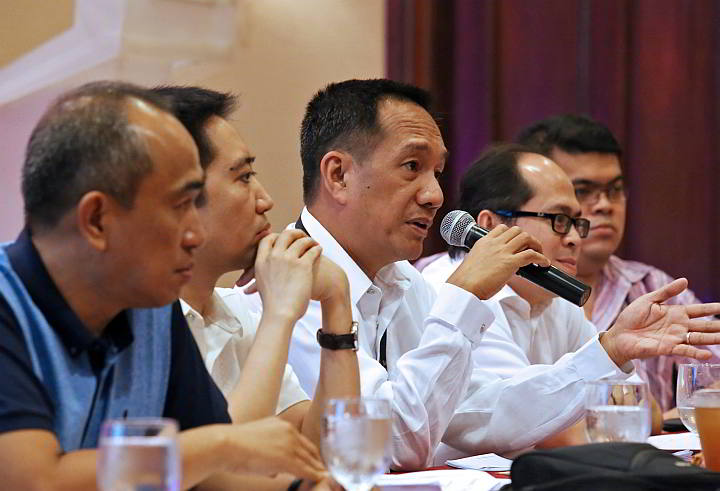
Engineer Nigel Paul Villarete (center with microphone), Mactan Cebu International Airport general manager, discusses the proposed airline incentives for landing and take-off at yesterday’s public hearing at the Waterfront Hotel Mactan. Those present included Ahmed Cuizon, MCIA assistant general manager (from left); lawyer Albert Abragan, Civil Aeronautics Board representative; Gerard Panga, Department of Tourism market development group representative; and lawyer Glen Napuli, MCIA legal department representative.
(CDN PHOTO/JUNJIE MENDOZA)
Granting incentives to airlines that introduce more flights at the Mactan Cebu International Airport will bring more tourists and investments to Cebu.
More job opportunities will also be created, said airport general manager Nigel Paul C. Villarete.
He led the discussion during a public hearing yesterday on the plan to provide incentives to airlines that offer new routes or increase flight frequencies from the Mactan Airport.
As proposed, airlines will get a 30 – 75 percent rebate on landing and take-off fees for long-haul international flights, depending on the frequency of flights per week and the size of the aircraft.
For domestic routes, airlines can avail of rebates as low as 25 percent to as high as 50 percent on landing and take-off charges.
There are no incentives for existing routes, or routes with a total departure from MCIA of more than or equal to seven times per week. The incentives will be given only for one year and only to routes that have continuous services.
Villarete said the plan was ready for final approval by the Mactan Cebu International Airport Authority board.
But he said they were still open to suggestions on how to improve the incentive plan, especially from the airlines.
Representatives from Philippine Airlines and Cebu Pacific Air yesterday suggested extending the period covered to at least two years from the proposed one year. They pointed out that there are routes that take longer to set up. They also proposed the inclusion of charter flights in the incentive plan.
Villarete said these suggestions will be presented to the board.
He said the incentive program would benefit the entire airline ecosystem, from the local and national government down to the airport ground handlers.
“All of us will be benefited here, DOT foremost, because of the target of 10 million tourists by 2016. All of the tour operators, tour guides, hotels and resorts and the entire economy will be benefited from any increase in routes. That’s why we are happy with the cooperation of everybody,” Villarete said.
Villarete said the air transport industry is a major driver for both national and international economy. Because of its growth in the recent years, the industry has become a lot more competitive.
He said airports around the world are trying to outdo each other by offering airlines better incentives.
“Airports are actually vying for more airlines. They always ask what incentives we can give to airlines,” he said.
Airports that have competitive incentive plans include Tokyo’s Narita International Airport, Singapore’s Changi Airport, Orlando International Airport and Airports of Thailand.
Hartsfield-Jackson Atlanta International, the world’s busiest airport, is also trying to draw in more flights through incentives.
“It doesn’t mean that if you are a big and busy airport, you won’t want more,” said Villarete.
Villarete said the proposed incentive plan is a ladderized system, which any airline can avail of if they add new routes, increase the frequency of their flights per week, or upgrade their aircraft.
The incentive plan will complement the P17.52-billion public-private partnership (PPP) project to upgrade the airport.
Concession holder GMR Megawide Cebu Airport Corp. (GMCAC) has started improving the existing passenger terminal. It targets to break ground for Terminal 2 (T2) next month and targets to complete it in August 2018.
The new terminal will increase the airport’s passenger carrying capacity to 12.5 million a year. Mactan’s existing terminal was designed for 4.5 million passengers, but currently serves more than 7 million.